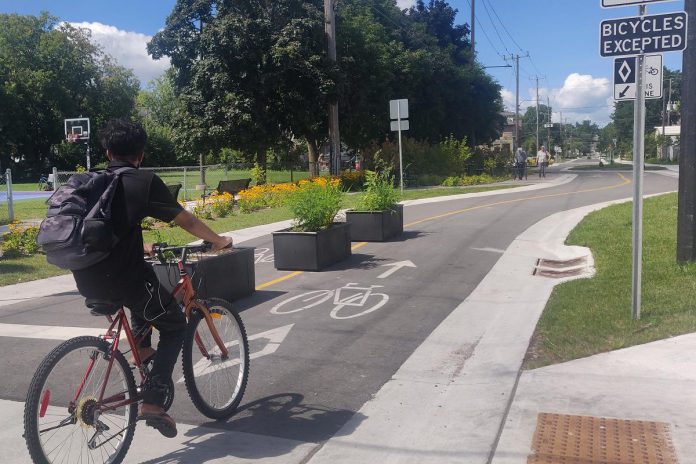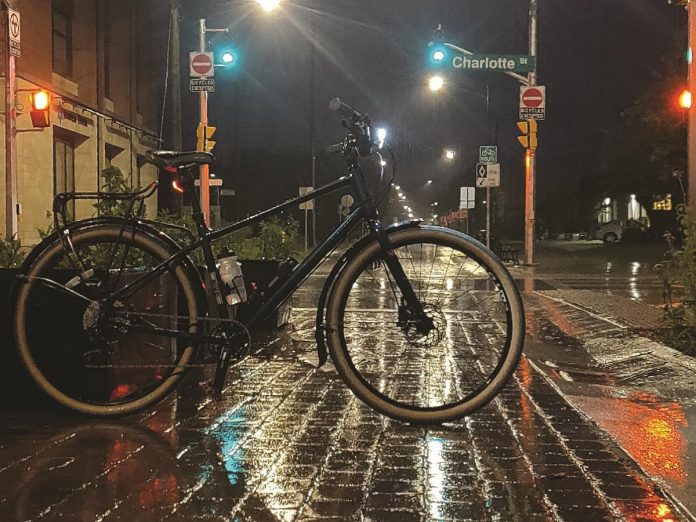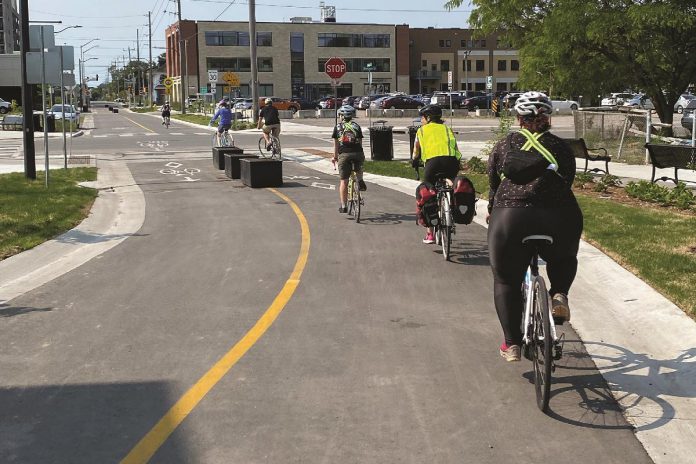
The City of Peterborough recently opened up its inaugural “bicycle priority” street, the Bethune Street bikeway.
Stretching from McDonnel Street to Townsend Street, this new streetscape introduces features like curved gardens that enhance traffic safety by slowing traffic, while providing garden spaces that absorb runoff and are home to native plants that support pollinators.
Intersections and pedestrian crossings are marked with brick pavers to heighten awareness, while sharrows — icons depicting a bike over a diamond — illustrate shared road space for cyclists and vehicles.
Bethune Street now best serves pedestrians and people on bikes. At intersections, vehicular traffic is channelled to arterial roads such as Aylmer Street to traverse downtown Peterborough on routes better suited to cars and trucks.
Underlying the transformation is vital stormwater infrastructure that will safeguard our city from intensifying climate-related storms.
The hidden marvel beneath the Bethune bike boulevard is the 1,600-metre “box culvert” sewer system. This underground network diverts floodwaters from Jackson Creek to the Otonabee River, safeguarding downtown homes and businesses from floods like those that devastated our downtown in 2004 and 2012.

This Bethune Street overhaul achieves dual goals: preventing catastrophic floods and prioritizing active transportation. It is a marked success in helping our community in our climate adaptation efforts.
The City of Peterborough secured $15.9 million in federal and provincial funding, primarily through the federal Small Communities Fund, to finance this climate adaptation project. This initiative involved constructing the Jackson Creek stormwater diversion sewer and revamping the sanitary sewer along Bethune Street.
Responding to climate change will continue to be a costly investment for communities everywhere.
The planning process for the new streetscape dates back to 2015-16 and involved robust community engagement for the Central Area (Bethune Street) Flood Reduction Project. The resulting 2017 Bethunescape Master Plan envisioned a pedestrian and cyclist-friendly corridor, enhanced green spaces, and the potential for spaces that could later be animated with community programming.
This vision is now realized, with the bikeway seamlessly joining the Trans Canada Trail and linking Peterborough’s core.
A bicycle-priority street like Bethune may initially pose an inconvenience as we learn new routes better suited for travel by car, but it is vital infrastructure for healthy, safe, and active transportation in our downtown.

Bethune’s success epitomizes the kinds of infrastructure that can be used to build an inclusive transportation system where people of all ages and abilities can travel comfortably.
Bethune Street also stands as a symbol urging citizens to embrace car-free travel, reduce their carbon emissions, and applauds climate-resilient infrastructure.
The phrase “if you build it, they will come” holds true on Bethune. It’s not just people on bikes embracing the new route for daily commutes. Families, mobility device users, tourists, and pedestrians all frequent this corridor, fostering an environment of relaxed and joyous mobility.
Bethune now accommodates diverse road users facilitating access to parks, work, and residences for people who do not have the option to drive or who choose other modes of travel.
For Freda Bourgon, who uses a power chair on Bethune almost daily with her son Sabastien, Bethune is a safer and smoother route across downtown.
In the recent past, they would often take George Street, but on Bethune, “with next to no cars,” Bourgon says, “it’s much safer going on this path, and it’s my son’s favourite spot — he calls it a shortcut.”

Bethune Street’s bikeway includes two new signalled intersections with state-of-the-art bicycle detection at Charlotte and Sherbrooke. Cyclists are able to roll up to the stop bar and are rewarded quite promptly with, fittingly, a green light in the shape of a bicycle.
“As a daily bicycle rider, I have never felt more at home in our city,” says Natalie Stephenson, director of programs at GreenUP and a Peterborough resident. “I feel like a road user who matters and whose needs have been prioritized.”
It’s time to celebrate this success for Peterborough and our natural environment.
We can reflect on the water flowing underneath us while using the bikeway and appreciate the work done to reduce our impact on the environment while prioritizing the city and its many inhabitants.
On Saturday, September 9th, from 1 to 4 p.m., GreenUP and B!KE: The Peterborough Community Bike Shop will host an event at Bethune and Simcoe Park. Join us in celebrating this significant stormwater and transportation project.
Bring your wheels and don blue attire for a bike parade to mark this milestone in Peterborough’s journey towards resilience!


























